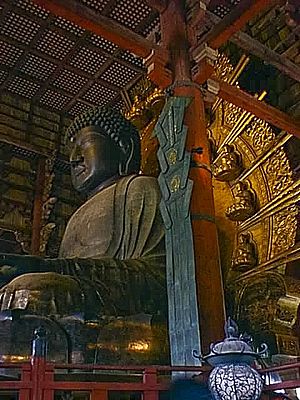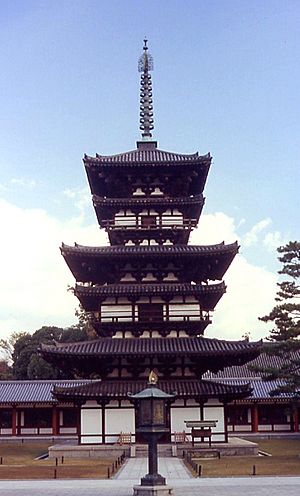Nara period facts for kids
The Nara period (which is called Nara jidai in Japanese) was an important time in the history of Japan. It lasted from the year 710 to 794. This period gets its name from the city of Nara, which was the capital city back then.

A New Capital City
In 710, Empress Gemmei decided to make a new capital city for Japan. She chose a place called Heijō-kyō, which is where the modern city of Nara is today. Empress Gemmei's palace was known as Nara-no-miya. For almost the entire Nara period, the next seven emperors and empresses ruled from this palace.
The capital city of Nara was designed to look like Chang'an. Chang'an was the capital of Tang China, a very powerful country at that time. Because of this, many ideas and parts of the culture from Tang China came to Japan during the Nara period.
Important Events
Here are some key events that happened during the Nara period:
- 710 (Wadō 3): Japan's capital city was officially moved to Nara (Heijō-kyō).
- 712 (Wadō 5): The Kojiki was finished. This is one of Japan's oldest history books.
- 720 (Yōrō 4): The Nihon Shoki was completed. This is another important historical record of Japan.
- 749-752 (Tenpyō-shōhō 1-4): Emperor Shōmu ordered the creation of a huge statue of Buddha (called Daibutsu) at Tōdai-ji temple.
- 760 (Tenpyō-hōji 4): The Man'yōshū was completed. This is a very famous collection of Japanese poems.
- 784 (Enryaku 3): The emperor moved the capital city from Nara to Nagaoka.
- 788 (Enryaku 7): The Buddhist monk Saichō started a monastery on Mt Hiei. This became a very important center for Buddhism in Japan.
- December 17, 794 (Enryaku 13, 21st day of the 10th month): The Emperor moved the capital again, this time from Nara to Heian-kyō. This marked the end of the Nara period.
Related pages
Images for kids
See also
 In Spanish: Período Nara para niños
In Spanish: Período Nara para niños




